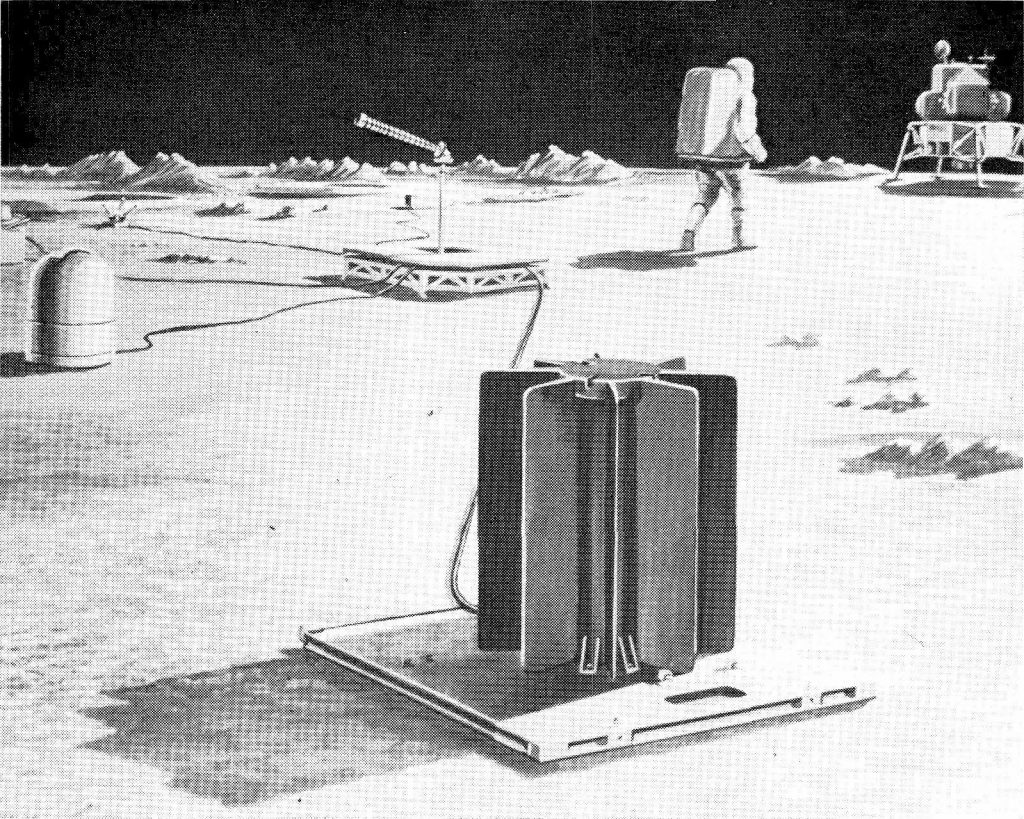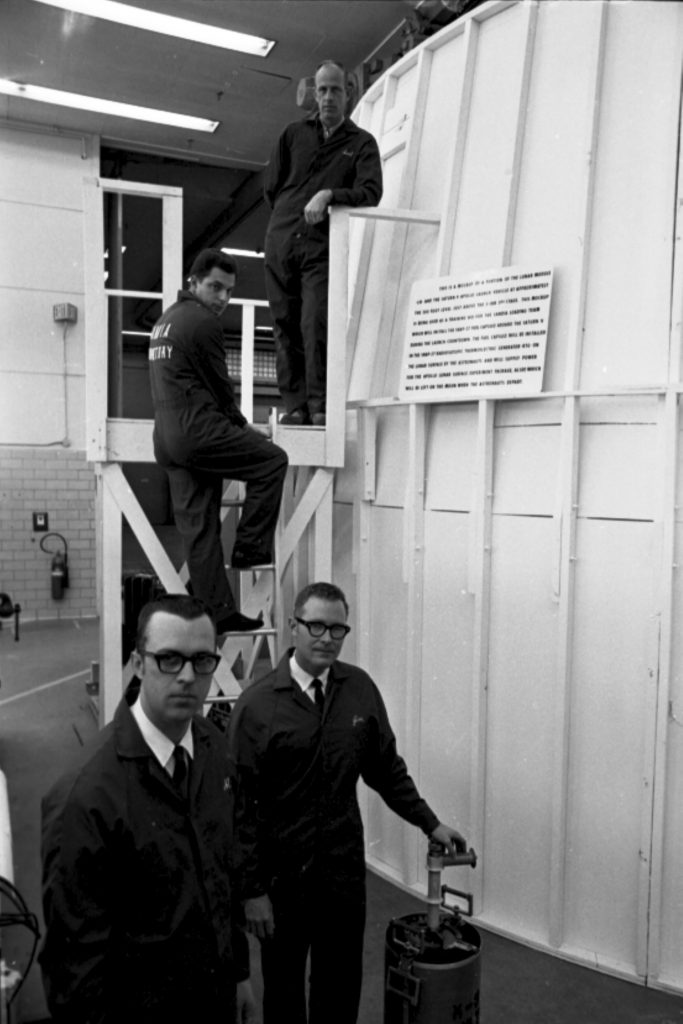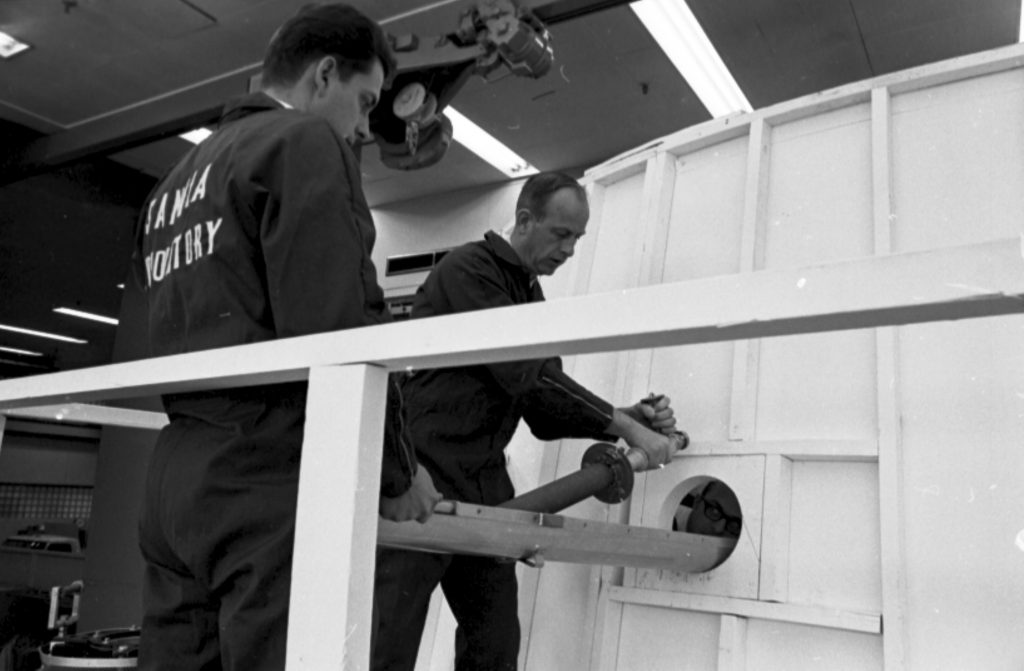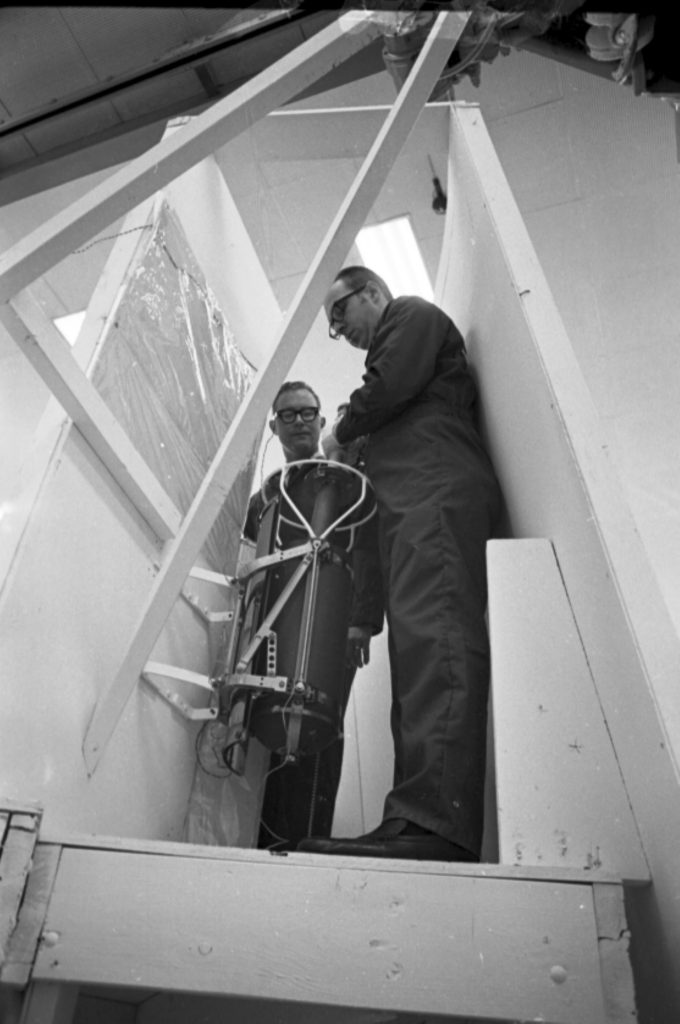From the May 23, 1969, Sandia Lab News:

The outstanding scientific achievement of the twentieth century will be placing a man on the moon.
Sandia will have, so to speak, a small but important piece of the action.
The last rehearsal flight to the moon is in space now. A team of six Sandians loaded a dummy SNAP-27 system on Apollo 10. Sandia will not participate in the launch of Apollo 11 which is the first scheduled landing on the moon’s surface later this summer. Apollo 12, 13, and 14, however, will carry the SNAP-27 isotopic power system and the Apollo Lunar Surface Experiments Package (ALSEP), a highly sophisticated array of scientific instruments which is expected to contribute immeasurably to prevailing theories of the evolution of the moon and earth.
The SNAP-27 system, which will provide power for the ALSEP, is Sandia’s concern.
AI Stephenson of Isotopic Power Systems Division and his team will support the Albuquerque Operations Office which has the responsibility of loading the SNAP-27 plutonium fuel capsule on the Lunar Module (LM). The fuel capsule with its surface temperature of 1375°F, is carried through space in a protective graphite cask on the outside of the LM. Once on the moon, astronauts will remove the fuel from its graphite cask and insert it into the SNAP-27 generator.
The loading job will be performed more than 330 feet above the ground at the top of the third stage engine of the giant Saturn V rocket which will boost the astronauts into space. The Sandians have attended several training schools in preparation for the task and have performed a number of “dry runs” during test countdowns at Cape Kennedy.
They are familiar with pad safety and the intricacies of working near “hypergolics” – the exotic and volatile fuel which is used in the spacecraft engines.
At the time of the SNAP-27 fuel capsule loading, five Sandians will be on the upper level of the gantry. Loading time for the capsule is T minus 15 hours. If all goes well, the Sandia job takes about 20 minutes. There are more than 100 specific actions in the countdown procedure which the Sandians must complete in the loading task. These actions are under the direction of the AEC/ALO Project Coordinator and are double checked by a NASA quality control officer who observes the loading.

In the high bay area of Bldg. 892, there is a wooden mockup of the LM and a portion of the Saturn V launch vehicle where the men have practiced the loading operation to perfection.
The emphasis on perfection is typical of Sandia’s involvement with the SNAP-27 generator. The system was developed under program guidance of the Space Nuclear Systems Division, AEC Headquarters, with the development contract administered by the Space and Special Programs Division of the Albuquerque Operations Office. Sandia is responsible for the technical direction of the program and for support of the safety aspects of the program. The Operational Safety Division is providing on-site assistance to the AEC Project Coordinator.
Jim Leonard is the project director who shares responsibility for the program’s technical direction with Al Stephenson and Tom Harrison. The safety activities are centered in Aerospace Nuclear Safety Department which oversees safety requirements for all of the SNAP devices.
Jim Leonard is also a member of the fuel capsule loading team along with Bob Wemple, Carl Sisson and Bob Pace and Watson Snyder (both assigned full-time to man Sandia’s Cape Kennedy facility). For the men on the team, the loading job is a secondary assignment performed only during Apollo launch activities.
Once placed inside its cavity in the SNAP-27 generator on the surface of the moon, the plutonium 238 fuel capsule’s heat will be converted to 70 watts of electrical energy by a thermopile consisting of lead telluride thermocouples in the generator.

Seven scientific experiments plus a data subsystem will be powered by the generator for a minimum period of a year. The Apollo Lunar Surface Experiments Package (ALSEP) will provide the scientific community with an unprecedented knowledge of the lunar environment – especially in the areas of seismology, geology, geophysics, geochemistry, particles and fields. The data will have a major impact on the evaluation of contemporary theories of lunar evolution.
One of the most interesting questions to be answered by the ALSEP instruments will be whether or not the moon evolved in the same pattern as now believed for the earth. Also, is the differentiation (structural composition and stratas) that exists on the moon similar to that of the earth? The ALSEP instruments will provide a means of measuring the moon rock layers in depth.
Seismic instruments will record the degree of moonquakes (if they exist) and the range of meteorite impacts. One of the instruments is designed to discharge (on command near the end of the operational year on the moon) a series of mortar explosions which will provide an artificial shock wave for the instruments to record.
Is the moon’s core a remnant of a molten body formed during the same period as the earth? If the core does exist, and is hot, then is it sustained by insulating layers of its mantle and supplied heat by radioactive decay? The ALSEP heat flow experiment will determine the net flow of heat outward from the moon’s interior and possibly answer these questions.

What kind of material makes up the moon’s core? Precise measurements of the flow of the interplanetary magnetic field through the moon by an ALSEP magnetometer instrument will tell if the moon attracts or repells this interplantery field. The data obtained from this experiment will aid in interpreting the composition of the moon.
It is possible that the lunar atmosphere is dominated by volcanic or other outgassing processes. Determining the amount, composition, and variation of the lunar atmosphere is the objective of another ALSEP experiment.
Interaction of the solar wind with the moon, as recorded by another ALSEP experiment, will provide an opportunity to study the effect of solar particles on the earth and the moon. The occasional violent outbursts of protons from the sun (related to solar flares) can be studied from the moon in ways not possible on earth because the earth’s magnetic field acts as a buffer in repelling solar wind particles. On the moon, where the magnetic field gradient is significantly less, scientific measurement of solar wind particles with ALSEP instruments will be possible.
Particles sent out by the sun set up currents through the moon which can be detected by the ALSEP solar wind spectrometer. The characteristics of these currents will aid in determining the conductivity of the moon. This data, combined with an analysis of the lunar magnetic properties, should give additional insight to the composition of the moon as a whole.
Project Apollo is under the direction of the National Aeronautics and Space Administration (NASA). Bendix Aerospace Systems Division is the prime contractor for the design, integration, test and systems management for the ALSEP package with scientific advisors from a variety of institutions and agencies.
The SNAP-27 program is conducted by the AEC’s Albuquerque Operations Office with technical direction by Sandia Laboratories. General Electric Company’s Missile and Space Division is the prime contractor. Mound Laboratories produces the plutonium fuel.